In this lesson, you will learn the easiest way to play the F chord on the guitar! Let’s Go!
The first thing you will need to do is to learn to barre across the strings like this: 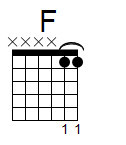
In order to do this, you need to lay on the left side of you first finger.
Primarily, because that is the boniest part of the finger, the hardest part of the finger, and it will be the easiest way to learn how to play the F chord or any barre chord on the guitar!
After you learn to barre two notes with you first finger, next you want to learn to barre three notes or strings with you finger. That looks like this: 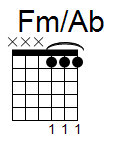
Essentially it’s an F minor chord with the 3rd, Ab, in the bass (also known as first inversion). If you not sure what that means, we’ll talk about it in another post when we discuss music theory for guitar.
Once we can hold three notes with a one barre finger, next up is holding four notes with our first finger barre: 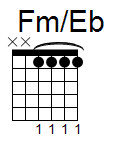
Please note: each time you play one of these chords, make sure that each note is coming out clearly, now buzzing or dead notes. One way to do that is make sure that the notes under the creases of you finger aren’t being muted (behind the knuckles). If that’s happening, you may need to move the finger up or down on the strings in order to move the crease of you finger away from the strings, so that the bonier, less fleshy part of you finger can press the string down instead. Also, keep checking that you still on the bony part of the finger.
Next after that is successful, you should now try to barre five strings from the A string down. That looks like this: 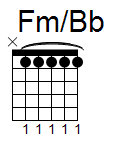
At this point, it’s probably getting pretty difficult. Don’t get discouraged, you got this! The good news, we only have one more to go, and that you actually don’t need to barre all the strings most of the time for most barre chords. We’ll talk about that later!
In the meantime, lets try one more before we start building the full F major barre chord. Also, keep in mind that each of these chords can be useful in Jazz and Fusion musical contexts! OK, here we go, are you ready?!
Last but not least, here’s what the last one looks like: 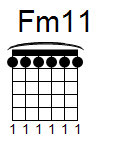
Again, I’ll explain the theory behind these (strangely named chords) in another post later. It will involve music theory for guitar.
Also, keep in mind you can move this chord shape up and down the neck to increase finger and hand strength! 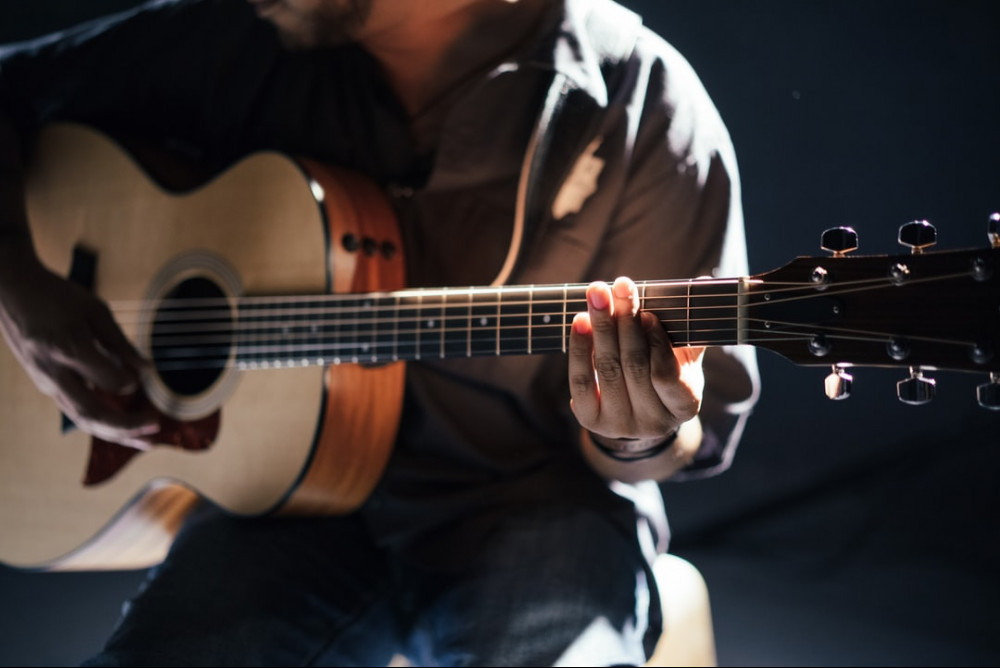
Building the F major chord
Here’s an easy way to play an F chord on the guitar
After you can barre several strings, now let’s try adding other fingers and let’s start building the F major chord. First let’s add the second finger.
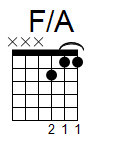
Please note: while the first finger is laying down across the two strings, i.e. E and B, the 2nd finger needs to be on it’s tip perpendicular to the fretboard.
Adding the third finger
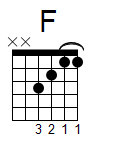
Keep in mind, that all of these versions of the F major chord are very useful, used in lots of songs. Don’t worry if you get stuck somewhere along the way. Just keep trying, you will get it!
Add the fourth (pinky finger)
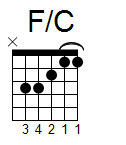
Again this one is used in lots of songs. Note that we just moved the third finger up to the A string, and replaced it with the pink on the D string, 3rd. Fret.
Full F major chord!
Finally, ADD THE FIRST FINGER BARRE.
Here it is, the full Monty: 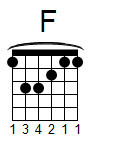 Even after all we’ve been through, it’s possible that one or more of the notes still aren’t coming out. Again, don’t get frustrated, you will eventually get it! You still have the easier versions of the F chord also to rely on. No shame in that, like I said lots of songs use the partial F chords.
Even after all we’ve been through, it’s possible that one or more of the notes still aren’t coming out. Again, don’t get frustrated, you will eventually get it! You still have the easier versions of the F chord also to rely on. No shame in that, like I said lots of songs use the partial F chords.
Note: Your not actually using just the 1st finger strength to get this chord. All the fingers need to be equally strong! And also realize that you actually only barring three notes, not six!
Hopefully, now you can play an F major chord on the guitar!
Song examples that use the F barre chord include: Wanted Dead or Alive, Ho Hey by the Lumineers, Like A Rolling Stone, Learning To Fly, Smells Like Teen Spirit (although modified somewhat)…
Wanted Dead Or Alive
Ho Hey
Like A Rolling Stone
Learning To Fly
Smells Like Teen Spirit
Other ways to gain mastery of the F chord
The C to F major 7 trick
Here’s another way to practice the F chord. First try playing an open position C chord:
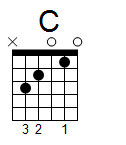 Next let’s play a variation of the F chord called F major 7:
Next let’s play a variation of the F chord called F major 7: 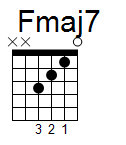 Notice that the first finger is common between both of these chords. Then to transition to the F maj7 from the C chord, all we had to do was just move the second and third fingers down from D string and A string (C chord) to the G-string and D string (Fmaj7).
Notice that the first finger is common between both of these chords. Then to transition to the F maj7 from the C chord, all we had to do was just move the second and third fingers down from D string and A string (C chord) to the G-string and D string (Fmaj7).
Now I would practice switching these chords until they are easy to switch back and forth. A good song that illustrates this is the Bob Dylan song – Like A Rolling Stone, particularly the intro of the song. Also, note that Like A Rolling Stone uses the F chord (partial or full F chord) throughout.
Here’s another version of the F major 7 that works well with the intro of that song and others: 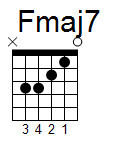
With that being said, you could also practice is this next way:
The C to F trick
Again let’s start with the C chord:
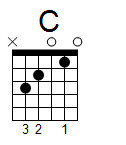 Now let’s try this chord shape:
Now let’s try this chord shape: 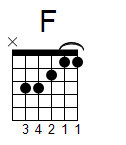 Notice here that the third finger can stay on the A string 3rd fret. Then the second finger moves from the D string (C chord) to the G-string (F chord). The pinky comes on to the D string, 3rd fret, and the first finger lays flat across the top two strings. Next practice this move several times until you can switch them smoothly. Have some extreme patience as the first finger learns to lay flat and learns to barre the top two strings (B and high E strings).
Notice here that the third finger can stay on the A string 3rd fret. Then the second finger moves from the D string (C chord) to the G-string (F chord). The pinky comes on to the D string, 3rd fret, and the first finger lays flat across the top two strings. Next practice this move several times until you can switch them smoothly. Have some extreme patience as the first finger learns to lay flat and learns to barre the top two strings (B and high E strings).
A song that uses this variation would be Bon Jovi – Wanted Dead or Alive
Csus4/ Fsus2/C
Another variation on the F chord actually shows how similar it truly is to a C chord:
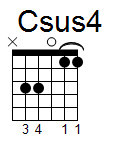 Now take a look at this chord:
Now take a look at this chord: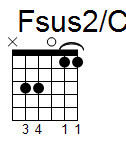 Notice that they are really the same chord voicing just with the notes rearranged. The notes in a Csus4 would be C F G C F, and the notes in a Fsus2/ C would be C (F G C) F. See it’s really the same notes. (Note: I put the F G and C notes in parentheses to show how the F chord technically is based on the F as the root, although here we put the C in the bass to illustrate a point!)
Notice that they are really the same chord voicing just with the notes rearranged. The notes in a Csus4 would be C F G C F, and the notes in a Fsus2/ C would be C (F G C) F. See it’s really the same notes. (Note: I put the F G and C notes in parentheses to show how the F chord technically is based on the F as the root, although here we put the C in the bass to illustrate a point!)
Learn the F7, Fmin7, etc.
Once you can play the full F barre chord, next you want to practice some other variations that are used in Blues, Folk tunes, and even Jazz (beginner to intermediate).
Here’s the first one: 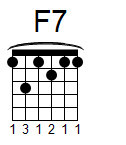 Now the question may arise – “What’s the difference between F major 7 and F7?” Good question! Essentially one note that is a 1/2 step different. An F major7 chord is spelled F A C E. The F7 chord spelling is F A C Eb. An F7 is a dominant chord so it’s function is different within a harmonic context, in other words within a chord progression. More information about that in another post!
Now the question may arise – “What’s the difference between F major 7 and F7?” Good question! Essentially one note that is a 1/2 step different. An F major7 chord is spelled F A C E. The F7 chord spelling is F A C Eb. An F7 is a dominant chord so it’s function is different within a harmonic context, in other words within a chord progression. More information about that in another post!
Just in case it’s needed: here’s another variation of the same chord as above: 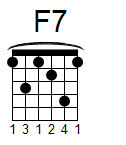
This one is a harder chord to learn because of the pinky on the 4th fret of the B string, but it’s useful if you can master it for blues, and early Rock N Roll or Rockabilly songs like Hound Dog by Elvis Presley!
Here’s another chord that you could use if you mastered it: 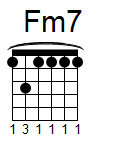
And a variation if needed: 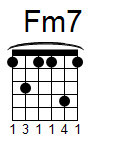
Finally, you should know this one also: 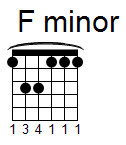
Moving it up down the neck to produce different chords
The next thing you want to do is move these chords up and down the neck to produce chords like Fm, F#m, Gm, etc.
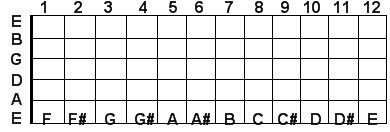
The root note, i.e. the note the chord is based on, is found on the low E string – the string closest to you chin (unless you play the guitar upside down).
The leverage trick
The next thing you want to try to do to master the F chord or any barre chord, is to apply pressure to the guitar body with you right arm, and then push you left hand toward the neck of the guitar. Do you feel the pressure on the neck when you do this? Now you don’t have to squeeze so hard with you hand/ fingers/ thumb.
Feel the weight of you hand on the neck (of the guitar)
Once in a Masterclass with a very talented classical guitarist (while I was in music school/ college studying music full time), I was told to “feel the weight of my hand upon the neck of the guitar.” Honestly, when I was first told this, I didn’t really know what he meant. It took a few years of remembering that comment and thinking about what it meant to realize he was right. Essentially, don’t squeeze with you left hand (between you fingers on the fingerboard, and you thumb on the neck) to play barre chords or really any chords for that matter. Instead, feel the weight of you hand on the neck of the guitar.
Extra: Learning to barre with other fingers…
In another post, I will address this in more detail, but for now…
After you have “mastered” the art of playing barre chords at least with a first finger barre chord, start practicing barring chords with other fingers such as you third finger (A form chords): 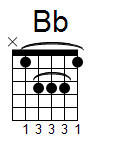
first finger like an open position A chord on the second fret of the D, G, and B strings: 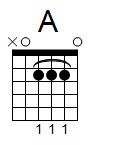
Or a less common way to the play the A chord is like this: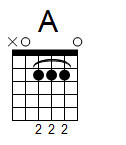 Some people like to play this chord that way. (Not my personal favorite, but I can do it). One other way to barre is with the weakest finger (usually, for most people):
Some people like to play this chord that way. (Not my personal favorite, but I can do it). One other way to barre is with the weakest finger (usually, for most people): 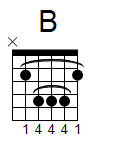 With the pinky… ouch… again not my favorite, but it is a good way to strengthen you pinky. Just don’t hurt yourself!
With the pinky… ouch… again not my favorite, but it is a good way to strengthen you pinky. Just don’t hurt yourself!
Conclusion
Mastering the F barre chord, or any barre chord, truly is a rite of passage for guitarists. It can take lots of patience, perseverance, practice, but it’s worth it in the end. Just think of how many new songs you being able to do once you can.
Wait, I know what you think, but what about capos? Why should I learn to do barre chords, when I can just use a capo… OK, for many songs that does work, but there are quite a few songs that use a capo that you still have to use an actual barre chord for at least one of the chords within the song, i.e. Wicked Game, or you have a least one chord that should be played open like Lightning Crashes: Lightning Crashes Tab.
In the meantime, keep practicing and keep playing the F chord on the guitar!
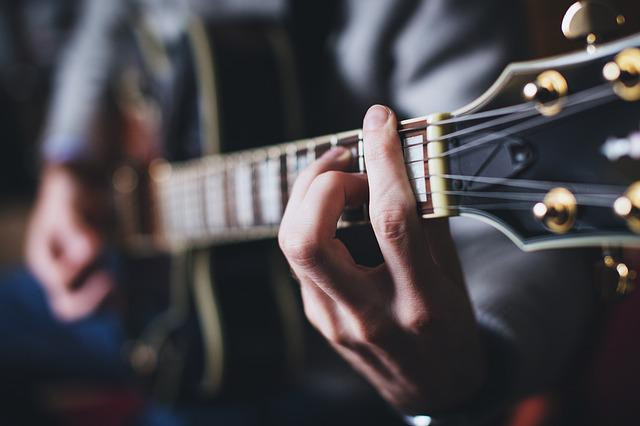
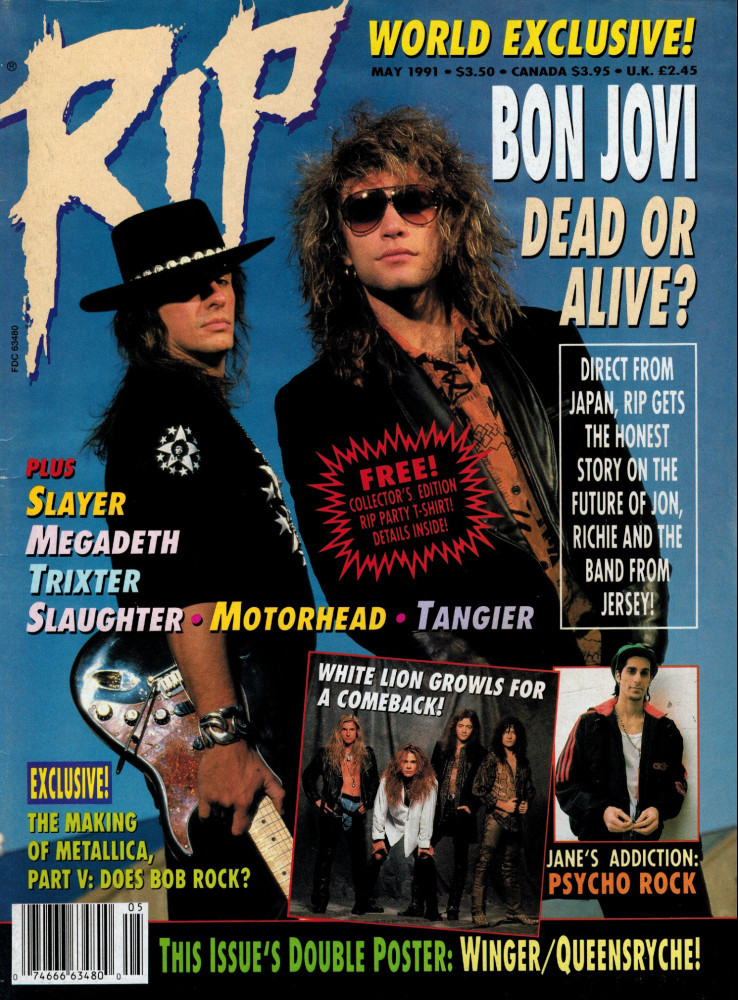

Wow, thank you very much for this valuable and detailed post about playing the guitar. I really like to play the guitar. But I am not that good. I have a guitar. I practice alone most of the time. This post means a lot to me. I can get used to this now. Keep posting like this. I will definitely bookmark this.
Awesome! I’m glad I could help. Let me know if you ever need any more help, I give lessons online virtually…